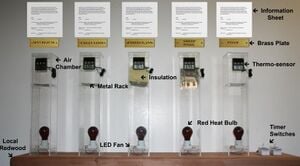
The Samoa Hostel is a joint effort of DANCO and the Humboldt Bay Center for Sustainable Living. Their goal is to incorporate sustainable living solutions into a hostel. They seek to do so by educating visitors about energy efficiency and sustainability. The hostel has a variety of displays and models illustrating environmentally friendly alternatives to common housing components. Our group was asked to construct an informational display designed to compare the efficiency and environmental impact of conventional and alternative insulation types.
Abstract[edit | edit source]
Fiberglass insulation is currently one of the most widely used insulation types because of it's insulating capabilities. However, it requires a lot of heat energy and mined resources to manufacture, and cannot be considered a sustainable energy solution. The Insulation Station is a project made to effectively compare conventional insulation types, particularly fiberglass, to alternative insulation types, and ultimately promote sustainability.
Problem Statement & Criteria[edit | edit source]
Problem Statement:
The Insulation Station addresses the problem of inefficient insulation. The purpose of the display is to educate visitors about the effectiveness insulation types and their relative costs
Criteria: listed in order of importance
- Educational Value
• Draws a Crowd
• Obvious Effects of Insulation
• Easy to Use
• Safety
• Cost
• Utilizes Local Materials
• Visual Appeal
• Multiple Insulation Types
• Inspirational Value
• Sturdy & Durable
Description of Final Product[edit | edit source]
The Insulation Station is an interactive display (Fig. 1) that compares the relative effectiveness of conventional and sustainable insulation types. The display showcases and informs about five types of insulation: Fiberglass, Foam Board, Cellulose, Sheep's Wool, and Mycelium. Each insulation type is housed in a Plexiglas tower set on a recycled, old-growth redwood counter. The towers have a blue LED fan and red heat bulb (Fig. 2) to provide warmth and air circulation. A thermo-sensor (Fig. 3) is placed above the insulation to show how effectively the insulation prevents heat and air from passing. Visitors approach the unit and activate electrical timers (Fig. 4) to turn on the heat bulbs and the fans. They will then notice the information sheets and learn about each insulation's R-value, relative cost, health and environmental impacts.
-
Various components of The Insulation Station
Cost[edit | edit source]
The Insulation Station retail cost is $797.34. However Greenbelt Creations was able to obtain various donations on necessary materials which allowed the actual price to conclude at $439.81. The model is consisted of five individual towers directly comparing the amount of heat obtained after it has passed through the insulation sample.
| Material | Description | Our Cost ($) | Actual Cost ($) |
|---|---|---|---|
| Plexiglass | 16sq ft--1/4" thick | 5.00 | 120.00 |
| Plexiglass | 7sq ft --1/8" thick | 0.00 | 55.00 |
| Redwood | 5ft 2"x12" | 20.00 | 30.00 |
| Brass Nameplates | 3"x7" | 7.50 | 180.00 |
| Fans | 40mm Chipset Fan | 34.95 | 34.95 |
| Thermosensors | RT8101E 2"x2" | 132.06 | 132.06 |
| Timers | 2-15 mins | 31.98 | 31.98 |
| Wall Plate | 1G Black | 1.98 | 1.98 |
| Heatlamp Bulbs | 6 40W | 41.34 | 41.34 |
| Power Adapter | For Fans | 40.00 | 40.00 |
| Porcelain Light Fixtures | 1.5"x2.0" | 30.00 | 30.00 |
| Wire Caps | 20 small | 5.00 | 5.00 |
| Power Strip | 4-6ft | 20.00 | 20.00 |
| Hardware | Mounts & Screws | 50.00 | 50.00 |
| Insulation Samples | 4"x4"x3.5" | 0.00 | 0.00 |
| Metal Screen | 4"x4" | 0.00 | 5.00 |
| Power Cords | For Lights | 20.00 | 20.00 |
| Total Cost | $439.81 | $797.34 | |
Greenbelt Creations[edit | edit source]
Greenbelt Creations is a design team of 4 Environmental Resources Engineering students that was created to do work for the Samoa Hostel during our Engr 215 design course.
Our design team consisted of Galen O'Toole, Shane Mallory, Nathan Payne & Marshall Clarke.
References[edit | edit source]
EnergySavers (2010). "Energy Savers: Types of Insulation." EnergySavers, <[1]>
Zero By Degrees (2009). "Insulation Guide." Insulation Types, <[2]>
Perlite (2010). "Loose-Fill Insulation." Perlite Info,< [3]>
RAN (2010). "Soy and Rainforest Destruction." Ran, <[4]>
EcoVative (2010). "Ecovative Greensulate." Ecovative, <[5]>
